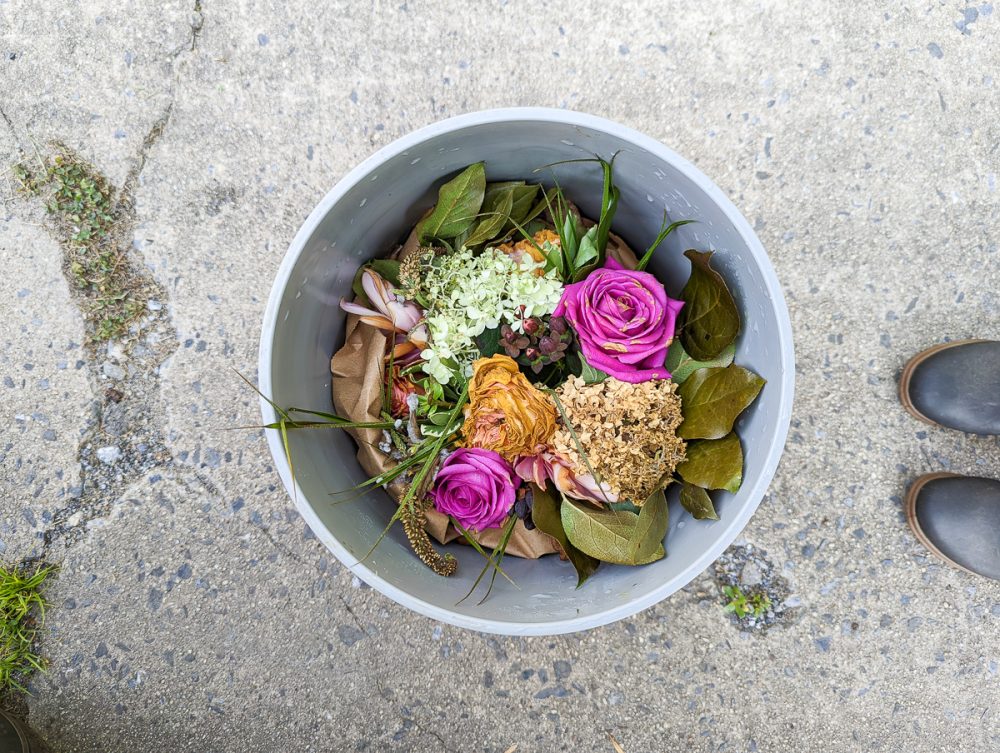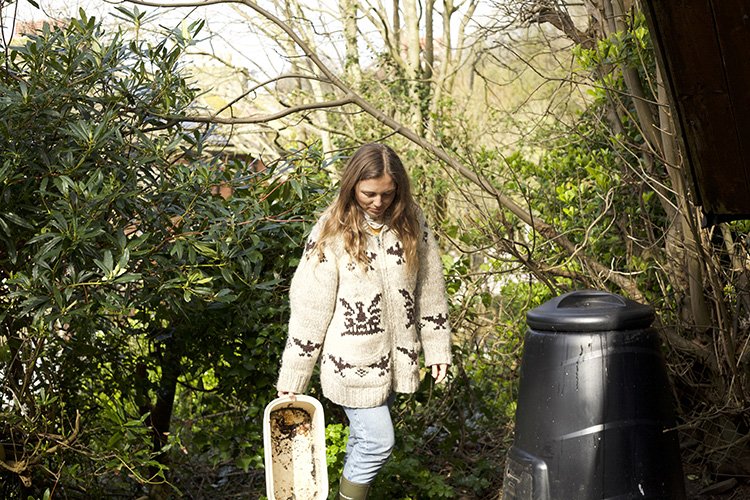6 Ways To Keep Your Curbside Composting Bucket Clean
Wondering how to keep your compost bucket clean and free of muck? Check out these five tips for cleaner composting at home.
This post contains affiliate links.

For the last two years, as the owner of WasteWell, a curbside composting company, I made it a goal to help my customers keep their compost buckets clean. While clean buckets make the composting experience more enjoyable and less intimidating for the customers, it’s also a bit of a selfish endeavor. Cleaner buckets make the job of emptying buckets on the pickup route 1,000 times easier and faster.
On that note, let’s talk about how to keep your compost bucket clean. Whether your use a pick-up service, drop off your scraps periodically at a composting site, or simply let them collect in a bucket for a while before you dump them in your outdoor processing system, a clean bucket just feels better (at least to me).
My suggestions relate primarily to larger buckets that collect multiple weeks’ worth of food scraps and land at the curb for collection, but many of these strategies can help keep your countertop compost buckets clean too.

Wipe Your Compost Bucket Clean After Emptying
A dirty and gross bucket tends to get more dirty and gross with each use. Shocking, I know. A quick swipe with a towel to wipe out extra remnants and moisture goes a long way toward keeping your compost bucket clean.
At WasteWell, I did this for the customers. After I emptied the bucket during collection, I wiped it with a paper towel (if it was really mucky) or a reusable cloth (made from old, cut-up t-shirts) to clean it out. I gave it a quick spray and wiped it with Blueland all-purpose spray and it’s nearly good as new.

Use a Liner in Your Bucket
There are many types of liners that help keep your food scrap bucket clean. I have tried newspaper, compostable bio bags, and brown paper bags.
Newspaper is fine but not great. It gets sloppy and sticks to the bucket pretty quickly. Compostable bags are alright, but they often degrade in the bucket and break when I empty the bucket. They are typically the most expensive option of the bunch, and I don’t think they perform the best. They also don’t break down well in backyard compost bins if you’re composting yourself.
Brown paper bags (like repurposed grocery bags) are the best. They absorb a good amount of moisture and break the least. Even when they do break, they keep the inside of the bucket the cleanest.
After swiping each bucket clean, I add a brown paper bag liner to my bucket. It’s made a huge difference in keeping much of the muckiest mess contained inside the liner and not sticking to the sides of the bucket.

Add Browns To Your Compost Bucket
Most of the mess in a compost bucket starts with excess moisture from all the greens (like food scraps) that collect in the bucket. Adding browns to the bucket – things like ripped-up cardboard, toilet paper tubes, shredded paper, or used paper towel – help absorb a lot of the moisture before it creates a comfortable environment for all the goop.
The brown paper bag liner mentioned above is the first “brown” added to the bucket and additional brown components layered over time can make your compost bucket a whole lot easier to manage. As an added bonus, browns can help prevent maggots in your compost bucket too. Without enough moisture, they can’t thrive. The browns literally suck the life out of the breeding environment.
Related Read: How to Prevent Maggots in Your Compost Bucket
Keep Your Compost Bucket in a Cool Area
Compost decomposes faster in warm temperatures. If you keep your compost bucket in a cool, dark place, it’s less likely to break down and get slimy and gross. Consider storing it in a place like a cool garage, under the sink, or in a closet.

Wrap Food Scraps in Bioplastic Bags
If you really want a clean compost bucket, wrap your food scraps in bioplastic bags before adding them to your bucket. Typically, people make this easy by keeping a small liner bag in their countertop bin and then just tying those bags up and putting them in the bucket.
If you use this method in conjunction with adding browns into the bucket or inside the bioplastic bags, your bucket will almost always stay very neat and clean (even in the heat of the summer). Just remember that all that bioplastic is fine in many commercial composting systems but won’t break down well if you compost in a smaller residential system or community composting setup.

Keep The Top of Your Compost Bucket on Tight
The organic matter in your bucket needs air to break down properly and effectively. Keep the top on your compost bucket to limit air into the bucket (and also to keep any stinky smells in the bucket).
Additionally, flies can get into open buckets and lay their eggs (i.e. maggots). Maggots breed more effectively when there is sufficient oxygen in the compost bucket, so keeping the lid on tightly (except when opening it to add scraps) can help reduce maggots in your compost bucket too.
Got any other tips to keep your compost bucket clean? Share them in the comments!

If You Like This Post, You Might Also Like
Composting at Home Resource Guide
Solar Power Resource Guide with EnergySage
Eco-Friendly Picture Books for Earth Day Every Day

Jen Panaro
Jen Panaro, founder and editor-in-chief of Honestly Modern, is a self-proclaimed composting nerd and advocate for sustainable living for modern families. To find her latest work, subscribe to her newsletter, Stepping Stones.
In her spare time, she’s a serial library book borrower, a messy gardener, and a mom of two boys who spends a lot of time in hockey rinks and on baseball fields.
You can find more of her work at Raising Global Kidizens, an online space to help parents and caregivers raise the next generation of responsible global citizens.







